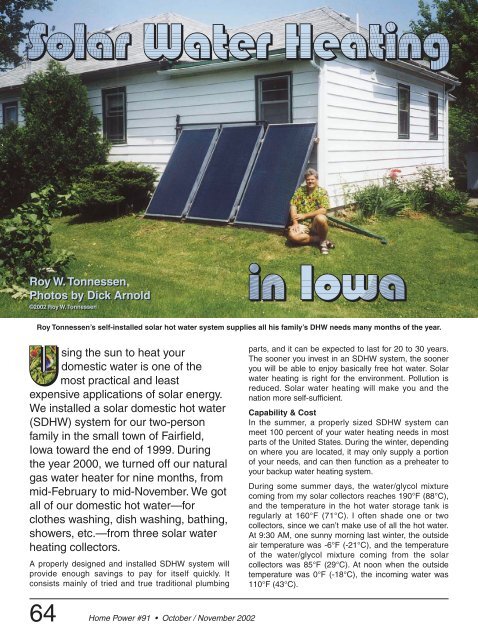Do-It-Yourself Solar Water Heating System in Iowa - Equal Parenting ...
Do-It-Yourself Solar Water Heating System in Iowa - Equal Parenting ...
Do-It-Yourself Solar Water Heating System in Iowa - Equal Parenting ...
You also want an ePaper? Increase the reach of your titles
YUMPU automatically turns print PDFs into web optimized ePapers that Google loves.
Roy W. Tonnessen,<br />
Photos by Dick Arnold<br />
©2002 Roy W. Tonnessen<br />
Roy Tonnessen’s self-<strong>in</strong>stalled solar hot water system supplies all his family’s DHW needs many months of the year.<br />
s<strong>in</strong>g the sun to heat your<br />
domestic water is one of the<br />
most practical and least<br />
expensive applications of solar energy.<br />
We <strong>in</strong>stalled a solar domestic hot water<br />
(SDHW) system for our two-person<br />
family <strong>in</strong> the small town of Fairfield,<br />
<strong>Iowa</strong> toward the end of 1999. Dur<strong>in</strong>g<br />
the year 2000, we turned off our natural<br />
gas water heater for n<strong>in</strong>e months, from<br />
mid-February to mid-November. We got<br />
all of our domestic hot water—for<br />
clothes wash<strong>in</strong>g, dish wash<strong>in</strong>g, bath<strong>in</strong>g,<br />
showers, etc.—from three solar water<br />
heat<strong>in</strong>g collectors.<br />
A properly designed and <strong>in</strong>stalled SDHW system will<br />
provide enough sav<strong>in</strong>gs to pay for itself quickly. <strong>It</strong><br />
consists ma<strong>in</strong>ly of tried and true traditional plumb<strong>in</strong>g<br />
parts, and it can be expected to last for 20 to 30 years.<br />
The sooner you <strong>in</strong>vest <strong>in</strong> an SDHW system, the sooner<br />
you will be able to enjoy basically free hot water. <strong>Solar</strong><br />
water heat<strong>in</strong>g is right for the environment. Pollution is<br />
reduced. <strong>Solar</strong> water heat<strong>in</strong>g will make you and the<br />
nation more self-sufficient.<br />
Capability & Cost<br />
In the summer, a properly sized SDHW system can<br />
meet 100 percent of your water heat<strong>in</strong>g needs <strong>in</strong> most<br />
parts of the United States. Dur<strong>in</strong>g the w<strong>in</strong>ter, depend<strong>in</strong>g<br />
on where you are located, it may only supply a portion<br />
of your needs, and can then function as a preheater to<br />
your backup water heat<strong>in</strong>g system.<br />
Dur<strong>in</strong>g some summer days, the water/glycol mixture<br />
com<strong>in</strong>g from my solar collectors reaches 190°F (88°C),<br />
and the temperature <strong>in</strong> the hot water storage tank is<br />
regularly at 160°F (71°C). I often shade one or two<br />
collectors, s<strong>in</strong>ce we can’t make use of all the hot water.<br />
At 9:30 AM, one sunny morn<strong>in</strong>g last w<strong>in</strong>ter, the outside<br />
air temperature was -6°F (-21°C), and the temperature<br />
of the water/glycol mixture com<strong>in</strong>g from the solar<br />
collectors was 85°F (29°C). At noon when the outside<br />
temperature was 0°F (-18°C), the <strong>in</strong>com<strong>in</strong>g water was<br />
110°F (43°C).<br />
64 Home Power #91 • October / November 2002
<strong>Solar</strong> Hot <strong>Water</strong><br />
Dur<strong>in</strong>g the coldest days of w<strong>in</strong>ter, I see the temperature<br />
<strong>in</strong> the storage tank mov<strong>in</strong>g from 57°F (14°C) (the<br />
temperature of the city water) <strong>in</strong> the morn<strong>in</strong>g, to 80°F<br />
(27°C) at noon. The solar collectors clearly help to<br />
preheat my domestic water, and cut down on the time<br />
the natural gas water heater needs to run dur<strong>in</strong>g the<br />
w<strong>in</strong>ter months.<br />
What does it cost The Department of Energy (DOE)<br />
estimates that a professionally <strong>in</strong>stalled SDHW system<br />
of this size will cost US$2,000 to US$3,000. The parts<br />
for my system cost about US$900. I obta<strong>in</strong>ed several<br />
Yazaki, 3 by 6 ft. (0.9 x 1.8 m) collectors from a large,<br />
dismantled system. S<strong>in</strong>ce I had some extra used<br />
collectors, I traded with my neighbor Fred. He got three<br />
collectors <strong>in</strong> exchange for design<strong>in</strong>g and <strong>in</strong>stall<strong>in</strong>g my<br />
system. I provided my labor assistance for both his and<br />
my system.<br />
We bought most of the other parts from a local<br />
plumb<strong>in</strong>g supply store. They ordered some of the items<br />
for us, but most were <strong>in</strong> stock. We bought a stock tank<br />
(normally for water<strong>in</strong>g cattle) to use as the solar hot<br />
water storage tank, and built the heat exchangers <strong>in</strong>to it.<br />
We bought the sheets of <strong>in</strong>sulation for the tank from a<br />
local lumberyard. I bought my differential thermostat<br />
from Kera Technology <strong>in</strong> Canada, and a few items from<br />
AAA <strong>Solar</strong>.<br />
Conservation<br />
There is no cheaper, cleaner, or greener energy than<br />
energy that you don’t use—energy that doesn’t need to<br />
be produced. Before you consider <strong>in</strong>stall<strong>in</strong>g an SDHW<br />
system, determ<strong>in</strong>e what you can do to conserve water<br />
and energy. I <strong>in</strong>stalled two <strong>in</strong>sulat<strong>in</strong>g<br />
blankets around my natural gas<br />
water heater. I also cut to fit and<br />
<strong>in</strong>stalled a 2 <strong>in</strong>ch (5 cm) thick sheet<br />
of <strong>in</strong>sulat<strong>in</strong>g board on top of it. (Be<br />
careful not to obstruct air passage<br />
around the draft hood at the bottom<br />
of the flue.)<br />
I turned the water temperature<br />
sett<strong>in</strong>g on the water heater down to<br />
120°F (49°C). The only negative<br />
result of the lower thermostat sett<strong>in</strong>g<br />
was that the soap <strong>in</strong> the dishwasher<br />
didn’t dissolve completely. We chose<br />
to keep the thermostat sett<strong>in</strong>g low<br />
and turn on the electric temperature<br />
booster that is built <strong>in</strong>to our<br />
dishwasher. We thus use a little<br />
more electricity, but have had no<br />
more problems gett<strong>in</strong>g dishes clean<br />
and free of soap residue.<br />
We <strong>in</strong>sulated our hot water pipes and <strong>in</strong>stalled good<br />
quality, low-flow shower heads to cut down on the<br />
volume of hot water used. When my natural gas water<br />
heater gives up the ghost, I will probably <strong>in</strong>stall a natural<br />
gas, tankless, on-demand water heater. Some models<br />
are specifically designed to work with SDHW systems.<br />
Our <strong>Solar</strong> <strong>Water</strong> <strong>Heat<strong>in</strong>g</strong> <strong>System</strong><br />
We have an active, closed loop, flat plate collector<br />
system. This system is appropriate for a climate with<br />
freez<strong>in</strong>g temperatures. <strong>It</strong> can be switched to be either a<br />
one-tank or two-tank system.<br />
<strong>It</strong> is called “closed loop” because it has an antifreeze,<br />
heat transfer fluid that moves through the solar<br />
collectors <strong>in</strong> a circle or loop. <strong>It</strong> is called an “active”<br />
system because a small, electric pump moves the fluid<br />
through that closed loop. “Flat plate” collectors are the<br />
most common type of solar hot water collectors. They<br />
consist of a flat, <strong>in</strong>sulated, weatherproof box conta<strong>in</strong><strong>in</strong>g<br />
a dark absorber plate. The antifreeze liquid runs through<br />
passages <strong>in</strong> the absorber plate, where it absorbs the<br />
heat from the sun.<br />
The five major component groups <strong>in</strong> our solar hot water<br />
system are:<br />
• The solar collectors (panels). They capture the solar<br />
energy.<br />
• The storage tank. Here a reservoir of water is heated<br />
by one of the heat exchangers, and the heat is stored<br />
there for immediate or later use. A conventional water<br />
heater can be used for additional water storage for<br />
most of the year, and as a backup dur<strong>in</strong>g the w<strong>in</strong>ter.<br />
At the works—Roy’s maze of pipes is actually quite simple.<br />
Home Power #91 • October / November 2002<br />
65
<strong>Solar</strong> Hot <strong>Water</strong><br />
The s<strong>in</strong>gle, AC powered, Grundfos circulat<strong>in</strong>g pump.<br />
• The liquid-to-liquid heat exchangers. These transfer<br />
the sun’s heat <strong>in</strong>to your domestic hot water system. In<br />
my setup, one heat exchanger extracts the heat from<br />
the water/glycol mixture <strong>in</strong> the collection loop and<br />
transfers it to the water <strong>in</strong> the storage tank. The other<br />
heat exchanger warms the city water <strong>in</strong> the delivery<br />
system by transferr<strong>in</strong>g the heat from the water <strong>in</strong> the<br />
storage tank to the hot water we use.<br />
• The plumb<strong>in</strong>g system. <strong>It</strong> moves the heat, captured <strong>in</strong> a<br />
fluid mix of water and nontoxic glycol, from the<br />
collectors to a heat exchanger.<br />
• The differential thermostat/controller. This regulates<br />
the operation of the circulation pump.<br />
How <strong>Do</strong> the Panels Work<br />
When you open a car door on a warm summer day, you<br />
feel a blast of hot air, and the seats are too hot to sit <strong>in</strong><br />
comfortably. The car is basically a box of metal with<br />
open<strong>in</strong>gs covered by glass. The sun’s rays pass through<br />
the glass and heat up the <strong>in</strong>side of the car. The car acts<br />
as a solar collector.<br />
The flat plate solar collector works similarly, but better.<br />
The sun’s rays pass through the glass cover and hit the<br />
dark metal absorber plate below. The temperature on<br />
the metal surface may reach 250°F (121°C). The<br />
water/glycol mixture circulat<strong>in</strong>g through the absorber<br />
plate picks up heat. The <strong>in</strong>sulated, glass-covered<br />
collector helps conta<strong>in</strong> the heat. If you turn off the<br />
circulation pump <strong>in</strong> an SDHW system on a sunny day,<br />
the water/glycol mixture <strong>in</strong> a flat plate collector can<br />
easily reach boil<strong>in</strong>g temperatures.<br />
With most common collectors, many th<strong>in</strong> water pipes<br />
are sandwiched between two sheets of metal absorber<br />
plate, usually runn<strong>in</strong>g vertically. In my system, a small,<br />
Grundfos UPS 15-42, circulat<strong>in</strong>g pump pushes the<br />
antifreeze mixture of distilled water and nontoxic<br />
propylene glycol very slowly through the pipes. As the<br />
fluid exits the top of the solar collectors, it has picked up<br />
quite a bit of heat from the metal sheets.<br />
The liquid cont<strong>in</strong>ues from the solar collectors outside my<br />
house to the liquid-to-liquid heat exchanger at the<br />
bottom of the water storage tank located <strong>in</strong> my<br />
basement. As the hot liquid passes through the heat<br />
exchanger, some of the heat circulat<strong>in</strong>g through it is<br />
transferred to the water surround<strong>in</strong>g it <strong>in</strong> the water<br />
storage tank.<br />
The fluid is cooler after it has passed through my<br />
homemade heat exchanger, and is then pumped back<br />
to the solar collectors. If the sun is still sh<strong>in</strong><strong>in</strong>g, the cycle<br />
starts all over aga<strong>in</strong>, cont<strong>in</strong>u<strong>in</strong>g to heat the water <strong>in</strong> the<br />
storage tank. All of this happens <strong>in</strong> a closed loop where<br />
the water/glycol mix runs <strong>in</strong> a circle, and never mixes<br />
with the water <strong>in</strong> the storage tank. This part of the<br />
system is often called the collection or solar loop.<br />
Differential Thermostat<br />
The controller or bra<strong>in</strong> of our system is a Kera Tech<br />
DSD-2 differential thermostat (DT). The DT is used to<br />
turn the circulation pump on and off at the appropriate<br />
temperatures.<br />
A differential thermostat is not like the household<br />
thermostats you may be familiar with. <strong>It</strong> measures the<br />
difference <strong>in</strong> temperature between two po<strong>in</strong>ts, based on<br />
read<strong>in</strong>gs from two heat sensors. The two po<strong>in</strong>ts are the<br />
temperature at the outlet of one of our solar collectors,<br />
A Kera differential thermostat controls operation.<br />
66 Home Power #91 • October / November 2002
Air Vent & Pressure<br />
Relief Valve:<br />
Temperature Sensor<br />
<strong>Solar</strong> Hot <strong>Water</strong><br />
Roy Tonnessen’s<br />
<strong>Solar</strong> DHW <strong>System</strong><br />
Differential Thermostat:<br />
Kera Tech, DSD-2<br />
KERA<br />
120 VAC<br />
<strong>Solar</strong> Flat Plate<br />
Collectors:<br />
Three, 3 x 6 ft.<br />
Yazaki SC-201S<br />
City<br />
<strong>Water</strong> <strong>in</strong><br />
Gate Valve<br />
Boiler Dra<strong>in</strong>:<br />
Lowest po<strong>in</strong>t outside<br />
Gate Valve<br />
Gate Valve<br />
Ball Valve:<br />
<strong>Solar</strong> system bypass,<br />
closed<br />
Cold to<br />
House<br />
Temperature<br />
Gauge<br />
Hot to<br />
House<br />
Mix<strong>in</strong>g<br />
Heat Exchanger Tank: Valve<br />
120 gallon, galvanized steel,<br />
Non-pressurized<br />
Gate<br />
Valve<br />
Boiler Dra<strong>in</strong>s:<br />
Fill / dra<strong>in</strong> assembly<br />
Pressure<br />
Gauge<br />
Expansion<br />
Tank<br />
Stra<strong>in</strong>er<br />
T&P Relief<br />
Valve<br />
Hot<br />
Out<br />
Ball Valves:<br />
Backup system<br />
bypass, closed<br />
Check<br />
Valve<br />
<strong>Solar</strong> Coils:<br />
Six coils (two shown),<br />
10 ft. each, 1 /4 <strong>in</strong>. soft<br />
copper, bottom of tank<br />
DHW Coils:<br />
Three coils (one shown),<br />
60 ft. each, 1 /4 <strong>in</strong>. soft<br />
copper, top of tank<br />
Boiler Dra<strong>in</strong>:<br />
Lowest po<strong>in</strong>t <strong>in</strong>side<br />
Pressure Relief<br />
Valve<br />
Temperature<br />
Sensor<br />
Pump:<br />
Grundfos UPS 15-42 F,<br />
120 VAC, 3 speeds<br />
Preheated<br />
In<br />
Backup<br />
<strong>Water</strong> Heater:<br />
Natural gas,<br />
40 gallon<br />
and the temperature at the top of the solar hot water<br />
storage tank. If I set the DT at 19°F (11°C), it will search<br />
to see if the temperature <strong>in</strong> the solar collector is higher<br />
than the temperature <strong>in</strong> the storage tank. When the<br />
water/glycol mixture <strong>in</strong> the collector gets to be 19°F<br />
warmer than the water <strong>in</strong> the storage tank, the DT will<br />
start the circulation pump.<br />
The DT will cont<strong>in</strong>ue to register the difference <strong>in</strong><br />
temperatures. The pump will be turned off when the<br />
temperature <strong>in</strong> the solar collector is down to 6°F (3°C)<br />
warmer than <strong>in</strong> the storage tank. Our DT allows us to<br />
select any temperature differential from 3°F to 22°F<br />
(2–12°C) to start the pump. We can choose to let the<br />
circulation pump be turned off when the temperature<br />
difference is at any po<strong>in</strong>t between 2°F (1°C) and 12°F<br />
(7°C).<br />
Our unit has two digital displays, which alternate to<br />
show four different read<strong>in</strong>gs. At a glance, I can see the<br />
temperature of the water/glycol mixture <strong>in</strong> the collectors,<br />
the water temperature <strong>in</strong> the storage tank, and the two<br />
temperature differentials I have selected. On my DT, a<br />
light comes on when the circulation pump is runn<strong>in</strong>g.<br />
The pump is so quiet that I usually cannot hear it.<br />
Tank & Heat Exchanger Details<br />
An expansion tank automatically absorbs the changes<br />
<strong>in</strong> liquid volume and pressure. An air vent is <strong>in</strong>stalled at<br />
the highest po<strong>in</strong>t of the loop at the collector outlet. A<br />
check valve <strong>in</strong> the solar loop prevents reverse thermosyphon<strong>in</strong>g<br />
of the antifreeze mixture at night when the<br />
collectors become cooler than the storage tank. This<br />
sw<strong>in</strong>g check valve does not have much restriction to<br />
flow, and opens easily. <strong>It</strong> must be mounted <strong>in</strong> a vertical<br />
position so it is normally closed by gravity.<br />
A nonpressurized solar hot water storage tank houses<br />
the two heat exchangers. We used a galvanized steel<br />
cattle water<strong>in</strong>g tank. <strong>It</strong> is 5 by 2 by 2 feet (1.5 x 0.6 x 0.6<br />
m), and holds roughly 120 gallons (455 l) of water. For<br />
most of the year, when I turn off the gas water heater,<br />
Home Power #91 • October / November 2002<br />
67
<strong>Solar</strong> Hot <strong>Water</strong><br />
Tonnessen SDHW Costs<br />
<strong>It</strong>em<br />
we use the solar hot water storage tank for stor<strong>in</strong>g the<br />
water heated by the solar collectors before it enters my<br />
super-<strong>in</strong>sulated, conventional, 40 gallon (150 l), natural<br />
gas water heater. I then have a storage capacity of 160<br />
gallons (605 l). We have enough hot water stored to go<br />
without sunsh<strong>in</strong>e for two days. Our system is plumbed<br />
so that I can bypass the gas water heater tank if<br />
needed.<br />
My fabulous neighbor Fred is a master plumber. He<br />
designed and <strong>in</strong>stalled my system and one for himself,<br />
<strong>in</strong>clud<strong>in</strong>g the two liquid-to-liquid heat exchangers <strong>in</strong><br />
each system. <strong>It</strong> is important to have appropriately sized<br />
heat exchangers. Otherwise you may get disappo<strong>in</strong>t<strong>in</strong>g<br />
results.<br />
S<strong>in</strong>ce the water/glycol mixture com<strong>in</strong>g from the solar<br />
collectors will be warmer than the water <strong>in</strong> the supply<br />
l<strong>in</strong>e from the city, the heat exchanger <strong>in</strong> the solar loop is<br />
placed at the bottom of the hot water storage tank. This<br />
heat exchanger consists of six coils, each 10 feet (3 m)<br />
long, made from 1 /4 <strong>in</strong>ch (6 mm) soft copper<br />
refrigeration tub<strong>in</strong>g that the solar heated water/glycol<br />
mixture has to pass through.<br />
Some of the heat conta<strong>in</strong>ed <strong>in</strong> the 50/50 glycol/water<br />
mixture is transferred to the water <strong>in</strong> the storage tank.<br />
The warmer water rises toward the top of the storage<br />
tank where the second heat exchanger is placed. If we<br />
consume a lot of hot water, this will lower the<br />
temperature <strong>in</strong> the storage tank, but it is amaz<strong>in</strong>g how<br />
fast it jumps back up aga<strong>in</strong> on a sunny day.<br />
The heat exchanger <strong>in</strong> the delivery system is very<br />
similar. <strong>It</strong> consists of three coils, each 60 feet (18 m)<br />
long, 1 /4 <strong>in</strong>ch (6 mm) soft copper tub<strong>in</strong>g, that the cold<br />
city water com<strong>in</strong>g <strong>in</strong>to the natural gas water heater has<br />
Cost (US$)<br />
3 Yazaki SC-201S panels, <strong>in</strong>cl. plumb<strong>in</strong>g, <strong>in</strong>sulation, etc. (used) $259<br />
Kera DSD-2 differential thermostat with sensors 152<br />
Grundfos UPS 15-42 F circulation pump, 3 speed, 1 /25 hp 110<br />
Heat exchangers, homemade 100<br />
Stock tank, 5 x 2 x 2 feet, approximately 120 gallons 66<br />
Extrol #15 expansion tank 50<br />
Watts mix<strong>in</strong>g valve, 3 /4 <strong>in</strong>ch, brass 48<br />
Propylene glycol, 3 gallons (nontoxic) 47<br />
2 Adjustable pressure relief valves 39<br />
Air vent, float type 11<br />
Pressure gauge 10<br />
Check valve 10<br />
to pass through. This heat exchanger<br />
sits <strong>in</strong> the upper part of the water <strong>in</strong><br />
the storage tank that has been<br />
heated by the heat exchanger <strong>in</strong> the<br />
solar loop. This setup has worked<br />
extremely well so far.<br />
Total $902<br />
The amount of copper tub<strong>in</strong>g we<br />
used <strong>in</strong> the heat exchanger is a<br />
major reason for this system work<strong>in</strong>g<br />
so well. You need to have enough<br />
surface area for the cold water to<br />
travel through, so it can pick up a lot<br />
of heat from the water <strong>in</strong> the storage<br />
tank. The heat com<strong>in</strong>g from the solar<br />
collectors is transferred more easily,<br />
so its heat exchanger has less<br />
copper tub<strong>in</strong>g. S<strong>in</strong>ce I have a twotank<br />
system, 40 gallons (150 l) of hot<br />
water sits <strong>in</strong> the natural gas water<br />
heater, ready for use at any time. My family can take two<br />
showers and also use another faucet at the same time<br />
without any problems.<br />
The plumb<strong>in</strong>g code dictates that you have to use a<br />
double-walled heat exchanger, so two pipes will have to<br />
fail at the same time before there is any chance of<br />
contam<strong>in</strong>ation of your dr<strong>in</strong>k<strong>in</strong>g water. My setup with two<br />
s<strong>in</strong>gle wall heat exchangers submerged <strong>in</strong> a tank filled<br />
with nonpotable water should fulfill this requirement,<br />
s<strong>in</strong>ce there is still double protection. Nevertheless, you<br />
do not want to use traditional automotive antifreeze<br />
(ethylene glycol) <strong>in</strong> your solar hot water system, s<strong>in</strong>ce it<br />
is very toxic.<br />
The hot water delivery system consists of:<br />
• A homemade liquid-to-liquid heat exchanger <strong>in</strong>stalled<br />
toward the top of the water storage tank.<br />
• A pressurized 40 gallon (150 l) high-efficiency natural<br />
gas water heater.<br />
• A 3 /4 <strong>in</strong>ch mix<strong>in</strong>g valve.<br />
• Various valves, copper pipes, fitt<strong>in</strong>gs, and pipe<br />
<strong>in</strong>sulation.<br />
The mix<strong>in</strong>g valve is used to add cold water to the flow of<br />
water from the storage tank when the water exceeds a<br />
selected, preset temperature, to avoid scald<strong>in</strong>g. M<strong>in</strong>e is<br />
adjustable. The heat-sens<strong>in</strong>g element of a mix<strong>in</strong>g valve<br />
must be removed before solder<strong>in</strong>g, and re<strong>in</strong>stalled<br />
afterwards or it may be destroyed.<br />
Natural Gas Backup<br />
I have a direct-vent, high-efficiency, natural gas water<br />
heater. The ironic part of hav<strong>in</strong>g this so-called highefficiency<br />
unit is that an electric fan is needed to force<br />
68 Home Power #91 • October / November 2002
<strong>Solar</strong> Hot <strong>Water</strong><br />
The heavily <strong>in</strong>sulated, backup, natural gas water heater.<br />
air <strong>in</strong>to the burn chamber when it is runn<strong>in</strong>g. The good<br />
th<strong>in</strong>g is that this allows me to put the fan motor on a<br />
timer, which shuts down the heater. I have chosen to set<br />
it so that our natural gas water heater, dur<strong>in</strong>g the<br />
months that we use it, is turned off between 9:30 PM<br />
and 7:30 AM, which fits our lifestyle and daily rout<strong>in</strong>e.<br />
This alone will prevent the water heater from runn<strong>in</strong>g<br />
unnecessarily about 40 percent of the day, and there is<br />
no downside that I know of. You just need to allow the<br />
water heater to start 30 m<strong>in</strong>utes before you need hot<br />
water <strong>in</strong> the morn<strong>in</strong>g. The cost of the timer will be paid<br />
for <strong>in</strong> sav<strong>in</strong>gs <strong>in</strong> just a few months.<br />
For part of the year, we turn off our natural gas water<br />
heater completely. When I open a hot water faucet, the<br />
cold water from the city moves through a liquid-to-liquid<br />
heat exchanger immersed toward the top of the solar<br />
hot water storage tank. After it has been heated there, it<br />
passes through the natural gas water heater tank and<br />
cont<strong>in</strong>ues on to the faucet. So every time we use warm<br />
water, it circulates through the traditional water heater<br />
tank, unless I have switched it to bypass the tank. In<br />
effect, I have two hot water storage tanks. The water can<br />
get so hot <strong>in</strong> the summer that after it has passed<br />
through the heat exchanger, the mix<strong>in</strong>g valve mixes <strong>in</strong><br />
some cold water.<br />
Dur<strong>in</strong>g the coldest w<strong>in</strong>ter months, everyth<strong>in</strong>g functions<br />
much the same, except that the backup natural gas<br />
water heater is on. When I open the hot water faucet,<br />
the water is preheated by the heat exchanger <strong>in</strong> the<br />
solar hot water storage tank, and cont<strong>in</strong>ues <strong>in</strong>to the<br />
natural gas water heater, where the temperature is<br />
boosted as necessary to meet the thermostat sett<strong>in</strong>g.<br />
If the water is colder than the water heater thermostat<br />
sett<strong>in</strong>g, the natural gas heater will be activated and heat<br />
the water. If the water, preheated through the heat<br />
exchanger <strong>in</strong> the solar hot water storage tank, is warmer<br />
than the water heater thermostat sett<strong>in</strong>g, no backup<br />
heat<strong>in</strong>g is necessary, and it will flow through to the<br />
faucet, just as it does dur<strong>in</strong>g the summertime. The<br />
collection loop collects and transfers the heat from the<br />
sun, and the delivery system receives the heat and<br />
delivers it to the house <strong>in</strong> the form of hot water.<br />
<strong>System</strong> Siz<strong>in</strong>g, Location, Collector Orientation,<br />
& Tilt Angle<br />
We have enough hot water storage capacity to get us<br />
through two days without sunsh<strong>in</strong>e. That works very well<br />
<strong>in</strong> our climate. The average hot water consumption <strong>in</strong><br />
the US is 20 gallons (76 l) per person per day.<br />
We placed our solar collectors on the top of railroad ties<br />
dug partially <strong>in</strong>to the ground. The collectors are lean<strong>in</strong>g<br />
up aga<strong>in</strong>st the south-fac<strong>in</strong>g wall of the house, high<br />
enough off the ground to avoid ra<strong>in</strong> splash and snow.<br />
The collectors are anchored to the wall and to the<br />
railroad ties. We kept outdoor pipe lengths to a m<strong>in</strong>imum<br />
to avoid energy losses.<br />
Natural Gas Sav<strong>in</strong>gs<br />
Year 2001 with SDHW, compared to 1999 (last year before solar)<br />
Jan. Feb. Mar. Apr. May Jun. Jul. Aug. Sep. Oct. Nov. Dec.<br />
Reduction 27% 40% 88% 86% 100% 100% 100% 100% 100% 85% 83% 54%<br />
Year 2001 with SDHW, compared to 6 year average before SDHW system<br />
Reduction 72% 80% 92% 91% 100% 100% 100% 100% 100% 85% 91% 64%<br />
Home Power #91 • October / November 2002<br />
69
<strong>Solar</strong> Hot <strong>Water</strong><br />
<strong>Solar</strong> water heat<strong>in</strong>g panels may collect about twice as<br />
much energy dur<strong>in</strong>g an hour <strong>in</strong> July compared to<br />
January. So we have plenty of sunsh<strong>in</strong>e available <strong>in</strong> the<br />
summer, but we need to catch every possible ray <strong>in</strong> the<br />
w<strong>in</strong>ter.<br />
<strong>Solar</strong> collectors produce the most energy when their<br />
collection surfaces are perpendicular to the sun. Tilt<strong>in</strong>g<br />
collectors to match a particular site’s latitude will<br />
produce the greatest amount of energy on an annual<br />
basis. But the sun’s path is lower <strong>in</strong> the sky dur<strong>in</strong>g the<br />
w<strong>in</strong>ter months, and there’s less solar energy to collect.<br />
Sett<strong>in</strong>g the collectors at a steeper tilt angle gives us a<br />
leg up dur<strong>in</strong>g the w<strong>in</strong>ter because the panels are more<br />
perpendicular to the sun’s path.<br />
The three Yazaki panels are anchored to railroad ties.<br />
Home Power magaz<strong>in</strong>e is rooted <strong>in</strong> the spirit of do-ityourself<br />
<strong>in</strong>genuity and systems that work. In recognition<br />
of the fact that there are many right ways to design a<br />
successful system, we have asked <strong>in</strong>dustry professionals<br />
to offer their comments, critiques, tips, and techniques for<br />
the benefit of readers <strong>in</strong>cl<strong>in</strong>ed to homebrew their own<br />
solar hot water system. In some cases, op<strong>in</strong>ions may<br />
differ from the <strong>in</strong>stallation presented here.<br />
Heat Exchanger Design<br />
The heat exchanger used <strong>in</strong> this system performs well<br />
under conditions of low demand. Generally a s<strong>in</strong>gle pass<br />
of the domestic hot water (DHW) through a heat<br />
exchanger can result <strong>in</strong> poor performance if the DHW<br />
demand is high, such as when a shower and a wash<strong>in</strong>g<br />
mach<strong>in</strong>e are runn<strong>in</strong>g at the same time.<br />
The great length and narrow diameter of copper pipe<br />
used <strong>in</strong> this system is absolutely necessary to overcome<br />
the <strong>in</strong>herent <strong>in</strong>efficiency of this s<strong>in</strong>gle pass heat<br />
exchanger. Although the three, 1 /4 <strong>in</strong>ch coils provide<br />
plenty of surface area required for an effective heat<br />
exchanger, most residences subject to the Uniform<br />
Plumb<strong>in</strong>g Code are required to have a total crosssectional<br />
area of pipe equal to that of a 3 /4 <strong>in</strong>ch pipe<br />
serv<strong>in</strong>g a domestic water heater. Check with your local<br />
build<strong>in</strong>g <strong>in</strong>spector to be sure of requirements.<br />
Most closed loop systems use a much smaller but more<br />
efficient counter-flow heat exchanger configuration. Two<br />
pumps are used to circulate the two fluids simultaneously<br />
<strong>in</strong> opposite directions through the heat exchanger. This<br />
allows for the DHW to pass through the heat exchanger<br />
many times and the stored water is always available for<br />
times of high demand. The added cost of the additional<br />
pump, commercial heat exchanger, and electricity pays<br />
off <strong>in</strong> better performance over the life of the system. The<br />
exception is applications with a very low DHW demand.<br />
Tips from the Pros<br />
Air Vent<br />
Automatic air vents can be problematic <strong>in</strong> solar closed<br />
loop systems. They often fail under high temperature and<br />
pressures associated with solar water heat<strong>in</strong>g systems.<br />
Manual co<strong>in</strong> vents are generally adequate for householdsized,<br />
closed loop SDHW systems.<br />
Pressure Relief Valves<br />
Closed loop SDHW systems generally use pressure relief<br />
(PR) valves rated at about 50 to 75 psi.<br />
Temperature/pressure relief (T&P) valves, normally found<br />
on a hot water tanks, are not used <strong>in</strong> solar closed loops.<br />
They are generally rated to open at 210°F (99°C) or 125<br />
psi. Temperatures of solar closed loops may regularly<br />
exceed the 210°F rat<strong>in</strong>g.<br />
Pipe Insulation<br />
Buried <strong>in</strong>sulated pipe should be encased <strong>in</strong> 4 <strong>in</strong>ch PVC<br />
pipe or suitable protection to keep the <strong>in</strong>sulation from<br />
compress<strong>in</strong>g and los<strong>in</strong>g its <strong>in</strong>sulation value.<br />
Chuck & Smitty, AAA <strong>Solar</strong>,<br />
Albuquerque, New Mexico<br />
Temperature Stratification<br />
Ma<strong>in</strong>ta<strong>in</strong><strong>in</strong>g a high degree of temperature stratification<br />
with<strong>in</strong> the solar storage tank can improve system<br />
efficiency significantly. The hottest water near the top of<br />
the tank is the optimum source for hot water delivery. The<br />
coolest water at the bottom of the tank is the optimum<br />
source for supply<strong>in</strong>g the collectors. These heat<br />
exchangers are optimally located to take advantage of<br />
this pr<strong>in</strong>ciple, but would be even more effective <strong>in</strong> a taller<br />
tank with a higher degree of temperature stratification.<br />
The tank sensor is best located at the bottom of the tank<br />
<strong>in</strong> order to sense the coldest water <strong>in</strong> the tank. This will<br />
allow the system to operate longer each day to collect as<br />
much useful heat as possible.<br />
Ken Olson, SoL Energy & HP solar thermal editor<br />
70 Home Power #91 • October / November 2002
<strong>Solar</strong> Hot <strong>Water</strong><br />
Fairfield, <strong>Iowa</strong>, is located at 41 degrees northern<br />
latitude. To optimize our system for the w<strong>in</strong>ter months,<br />
we <strong>in</strong>stalled our collectors at a 56 degree angle. This<br />
has turned out to work very well. In our climate, this<br />
steep angle also helps keep the collectors free of snow.<br />
We used a simple angle <strong>in</strong>dicator, available at the local<br />
hardware store, to <strong>in</strong>stall the collectors at the desired<br />
angle. More details on collector sit<strong>in</strong>g, angle, etc. can be<br />
found <strong>in</strong> Ken Olson’s articles that are referenced <strong>in</strong> the<br />
Access section.<br />
Collector Shad<strong>in</strong>g<br />
We used a <strong>Solar</strong> Pathf<strong>in</strong>der (reviewed <strong>in</strong> HP16 and<br />
demonstrated <strong>in</strong> a video clip on HP’s <strong>Solar</strong>1 CD) to<br />
locate the collectors so that we would avoid shad<strong>in</strong>g<br />
between 9 AM and 3 PM. <strong>It</strong> is an <strong>in</strong>genious contraption.<br />
For each month of the year, it shows you how many<br />
hours the sun will sh<strong>in</strong>e on any location where you are<br />
consider<strong>in</strong>g plac<strong>in</strong>g solar collectors. <strong>It</strong> shows you any<br />
obstructions from build<strong>in</strong>gs, trees, hilltops, etc. that<br />
might appear <strong>in</strong> the path of the sun for that specific<br />
location.<br />
You can create a simple chart for each location and<br />
quietly sit down afterwards and calculate what<br />
percentage of the possible 100 percent you will be able<br />
to catch at each specific location. For example, if you<br />
move your collectors a few feet, you may be able to<br />
clear the shadow from a build<strong>in</strong>g nearby and thereby<br />
<strong>in</strong>crease the output of your collectors.<br />
Efficient Use Patterns<br />
When you <strong>in</strong>stall an SDHW system, you may f<strong>in</strong>d that<br />
you have a different attitude, and feel more connected<br />
with nature. You will look out the w<strong>in</strong>dow <strong>in</strong> the morn<strong>in</strong>g<br />
and see that it looks like a bright day, and then use your<br />
clothes washer or dishwasher. You may hold off do<strong>in</strong>g<br />
your laundry for a few days if it is overcast, and then try<br />
to squeeze <strong>in</strong> several loads when you have a bright,<br />
sunny day.<br />
You need to work with nature to get the most out of your<br />
solar water heat<strong>in</strong>g system. You also have to br<strong>in</strong>g your<br />
family or house mates <strong>in</strong>to the process before <strong>in</strong>stall<strong>in</strong>g<br />
a solar water heat<strong>in</strong>g system, s<strong>in</strong>ce you will benefit if<br />
everyone is will<strong>in</strong>g to change their rout<strong>in</strong>es now and<br />
then.<br />
If possible, use your dishwasher and clothes washer<br />
between 10 AM and 3 PM on days when the sun sh<strong>in</strong>es<br />
brightly. The hot water you use will then be easily and<br />
quickly replenished by the sun, without any need for<br />
help from your gas or electric water heater. You will then<br />
have a nice reservoir of hot water to last you through the<br />
sunless even<strong>in</strong>g and night, and keep you comfortable if<br />
the sun should hide beh<strong>in</strong>d a cloud for a day or two.<br />
<strong>Solar</strong> Hot <strong>Water</strong><br />
<strong>System</strong> Ma<strong>in</strong>tenance<br />
Weekly<br />
❏ Check that system pressure is 15 to 30 psi.<br />
❏ Check that pump is operat<strong>in</strong>g when it is sunny.<br />
❏ Remove snow if necessary.<br />
Monthly<br />
❏ Check for a dist<strong>in</strong>ct temperature differential<br />
between the supply and return pipes <strong>in</strong> the<br />
collector loop (15–20°F; 8–11°C is typical). A<br />
noticeable difference <strong>in</strong> temperature with bright<br />
sun is a good <strong>in</strong>dication that everyth<strong>in</strong>g is f<strong>in</strong>e,<br />
the pumps are work<strong>in</strong>g, and the heat exchange<br />
is good. <strong>Solar</strong> pros do this with one hand on<br />
each pipe if the system isn’t too hot. Caution!<br />
Test the pipe with a wet f<strong>in</strong>ger like you do an iron<br />
before us<strong>in</strong>g your hands. If it’s too hot or you<br />
want really accurate data, use a thermometer.<br />
❏ Check for leaks <strong>in</strong> the system and home—<br />
pressure relief valves, temperature pressure<br />
relief valve on the storage tank, faucets, bath,<br />
and shower.<br />
❏ Confirm that there is no shad<strong>in</strong>g of the collectors<br />
between 9 AM and 3 PM.<br />
❏ Check that the collectors are clean so that the<br />
sun can easily reach the dark absorber plate;<br />
clean the glass if necessary.<br />
Annually<br />
❏ Lubricate the circulat<strong>in</strong>g pump accord<strong>in</strong>g to the<br />
manufacturer’s recommendations (unless they<br />
are sealed bear<strong>in</strong>gs).<br />
❏ Check <strong>in</strong>sulation on pipes and tank.<br />
❏ Look for signs of leaks at roof penetrations.<br />
❏ Review energy bills to confirm sav<strong>in</strong>gs.<br />
Every Two Years<br />
❏ Check the domestic water side of the heat<br />
exchanger for scal<strong>in</strong>g. De-scale if necessary.<br />
(This can be done with a mild solution of<br />
muriatic acid and water or even v<strong>in</strong>egar if the<br />
scal<strong>in</strong>g is not pronounced. A symptom of heat<br />
exchanger scal<strong>in</strong>g is bright sun and pump(s)<br />
work<strong>in</strong>g, but little or no temperature differential<br />
between the supply and return pipes <strong>in</strong> the<br />
collector loop.<br />
❏ Check the pH (acidity or alkal<strong>in</strong>ity) of the<br />
propylene glycol heat transfer fluid. A pH of<br />
below 7 is a good <strong>in</strong>dication that the mixture<br />
needs to be changed.<br />
Home Power #91 • October / November 2002<br />
71
<strong>Solar</strong> Hot <strong>Water</strong><br />
Plumb<strong>in</strong>g Details<br />
We used ma<strong>in</strong>ly 3 /4 <strong>in</strong>ch, type L sweat-soldered copper<br />
pipes and some flexible, type M copper pipe, because it<br />
is easy to bend. We used a 95/5 t<strong>in</strong>-antimony solder <strong>in</strong><br />
the solar loop, and braz<strong>in</strong>g solder for the heat<br />
exchangers. These have higher temperature rat<strong>in</strong>gs<br />
than 50/50 t<strong>in</strong>-lead solder. The 50/50 solder conta<strong>in</strong>s<br />
lead, and should not be used on domestic water l<strong>in</strong>es.<br />
We used Rectorseal #5, yellow, soft-set, pipe thread<br />
sealant. Standard jo<strong>in</strong>t compounds for threaded fitt<strong>in</strong>gs<br />
will not prevent leaks <strong>in</strong> pipes filled with a water/glycol<br />
mixture.<br />
We placed gate valves on both sides of major<br />
components to allow us to service them without dra<strong>in</strong><strong>in</strong>g<br />
the whole system. They should not be <strong>in</strong>stalled <strong>in</strong> a way<br />
that can isolate the solar collectors from pressure relief<br />
valves and the expansion tank. Otherwise, the collectors<br />
could burst dur<strong>in</strong>g stagnation conditions, such as if the<br />
circulation pump fails on a sunny day while the ball<br />
valves are closed. We <strong>in</strong>stalled the circulation pump<br />
after the heat exchanger, where the water is cooler, to<br />
put less stress on it.<br />
We grounded the collectors to prevent damage from<br />
lightn<strong>in</strong>g. To make a cont<strong>in</strong>uous electrically conductive<br />
connection to ground, a copper wire jumper connects<br />
the collector frame to the copper pipe of the solar<br />
collector loop. Another ground wire is connected from<br />
the copper pipe to a suitable ground, such as ground<br />
rod. <strong>It</strong> is important to jumper around any dielectric<br />
unions, typically found on hot water heaters, or any<br />
other <strong>in</strong>terruptions <strong>in</strong> the electrical cont<strong>in</strong>uity between<br />
collectors and ground.<br />
The copper pipes <strong>in</strong> the solar loop and hot water<br />
delivery are very well <strong>in</strong>sulated outside and <strong>in</strong>side the<br />
house. To shield the <strong>in</strong>sulation from UV rays and provide<br />
some protection from birds and rodents who might<br />
otherwise love to use it as nest<strong>in</strong>g material, I chose to<br />
wrap all my <strong>in</strong>sulation with black tile tape (for jo<strong>in</strong><strong>in</strong>g and<br />
waterproof<strong>in</strong>g tub<strong>in</strong>g).<br />
We used Rubatex elastomeric pipe <strong>in</strong>sulation with 1<br />
<strong>in</strong>ch (25 mm) and <strong>in</strong> some places 1 /2 <strong>in</strong>ch (13 mm) wall<br />
thickness. In retrospect, I wish I had used <strong>in</strong>sulation with<br />
1 <strong>in</strong>ch wall thickness wherever possible. We did not<br />
<strong>in</strong>stall the pipe <strong>in</strong>sulation until we had pressure tested<br />
the system. Smitty at AAA <strong>Solar</strong> recommends pa<strong>in</strong>t<strong>in</strong>g<br />
the Rubatex <strong>in</strong>sulation with a product called Ruf Snow. <strong>It</strong><br />
is a white rubberized pa<strong>in</strong>t used to coat and seal mobile<br />
home roofs.<br />
We <strong>in</strong>stalled the sensor wires for the differential<br />
thermostat runn<strong>in</strong>g outside the <strong>in</strong>sulation, to protect<br />
them from the high pipe temperatures. The wires are<br />
covered and protected under the black tape that I<br />
wrapped around the <strong>in</strong>sulation. The sensors are<br />
<strong>in</strong>stalled <strong>in</strong> wells, special plumb<strong>in</strong>g fitt<strong>in</strong>gs that are made<br />
to accommodate these sensors. They allow you to<br />
remove or replace the sensors without los<strong>in</strong>g system<br />
pressure or fluids. They also protect the sensor from<br />
corrosion by avoid<strong>in</strong>g direct contact with the liquids.<br />
Change Your World<br />
<strong>Solar</strong> energy is wonderful because it is democratically<br />
distributed to the rich and the poor alike throughout the<br />
world. <strong>It</strong> is basically ours for the tak<strong>in</strong>g. One major<br />
challenge is how to efficiently collect, use, and store this<br />
energy. I have shared with you how we successfully<br />
<strong>in</strong>stalled our solar water heat<strong>in</strong>g system for a cold<br />
climate.<br />
If you are <strong>in</strong>spired to run out and start purchas<strong>in</strong>g<br />
plumb<strong>in</strong>g parts to build a solar water heat<strong>in</strong>g system,<br />
please take some time and learn more about the<br />
different types of SDHW systems, heat exchangers, etc.<br />
that are available. The system I have described has<br />
worked extremely well for my family, with our pattern<br />
and level of hot water consumption, <strong>in</strong> our climate, with<br />
our level of sunsh<strong>in</strong>e. But it may be that another system<br />
or setup will fit your situation better. You owe it to<br />
yourself to do some research to f<strong>in</strong>d the system that will<br />
work best for you.<br />
Margaret Mead’s well-known statement has been an<br />
<strong>in</strong>spiration to me: “Never doubt that a small group of<br />
thoughtful, committed citizens can change the world.<br />
Indeed it is the only th<strong>in</strong>g that ever has.”<br />
Access<br />
Roy W. Tonnessen, PO Box 1443, Fairfield, IA 52556<br />
Installation Guidel<strong>in</strong>es for <strong>Solar</strong> DHW <strong>System</strong>s, U.S.<br />
Department of Hous<strong>in</strong>g and Urban Development, May<br />
1980, HUD-PDR-407(2), by Frankl<strong>in</strong> Research Center,<br />
Philadelphia, Pennsylvania • Good, clear, draw<strong>in</strong>gs,<br />
explanations, def<strong>in</strong>itions, checklists, & suggestions<br />
Available via government depository libraries<br />
How to Install a <strong>Solar</strong> <strong>Water</strong> Heater; Closed Loop<br />
Antifreeze <strong>System</strong>, by James E. Cook, Save On <strong>Solar</strong>,<br />
1988. ISBN 0-9619932-0-0 • Very clear and<br />
straightforward • Available used<br />
Build Your Own <strong>Solar</strong> <strong>Water</strong> Heater, by Stu Campbell<br />
with <strong>Do</strong>ug Taff, Garden Way Publish<strong>in</strong>g, ISBN 0-88266-<br />
129-9 • Covers why and how different types of<br />
collectors work • Available used<br />
HP84, page 44, and HP85, page 40, articles by Ken<br />
Olson. • Outstand<strong>in</strong>g <strong>in</strong>formation, nice illustrations<br />
HP25, page 37, and HP27, page 64, articles by Tom<br />
Lane. • Sav<strong>in</strong>gs, payback, and siz<strong>in</strong>g for SDHW<br />
systems<br />
72 Home Power #91 • October / November 2002
<strong>Solar</strong> Hot <strong>Water</strong><br />
AAA <strong>Solar</strong> Supply, Inc., 2021 Zear<strong>in</strong>g NW,<br />
Albuquerque, NM 87104 • 800-245-0311 or 505-243-<br />
4900 • Fax: 505-243-0885 • <strong>in</strong>fo@aaasolar.com<br />
www.aaasolar.com • Educational & <strong>in</strong>formative Web<br />
site; SDHW components<br />
Ken Olson, SoL Energy, PO Box 217, Carbondale, CO<br />
81623 • Phone/Fax: 720-489-3798<br />
<strong>in</strong>fo@SoLenergy.org • www.solenergy.org<br />
Kera Technology, Andy Lukas, 1320 Midway Blvd., Unit<br />
21, Mississauga, ON L5T 2K4, Canada • 905-566-0823<br />
Fax: 905-566-9036 • keratech@<strong>in</strong>terlog.com<br />
www.<strong>in</strong>terlog.com/~keratech/thermsd2.htm • DSD-2<br />
differential thermostat<br />
Home Power #91 • October / November 2002<br />
73



![Robert T McQuaid [rtmq@stn.net] Sent: Friday, October 29, 2004 12 ...](https://img.yumpu.com/51070071/1/190x245/robert-t-mcquaid-rtmqstnnet-sent-friday-october-29-2004-12-.jpg?quality=85)







